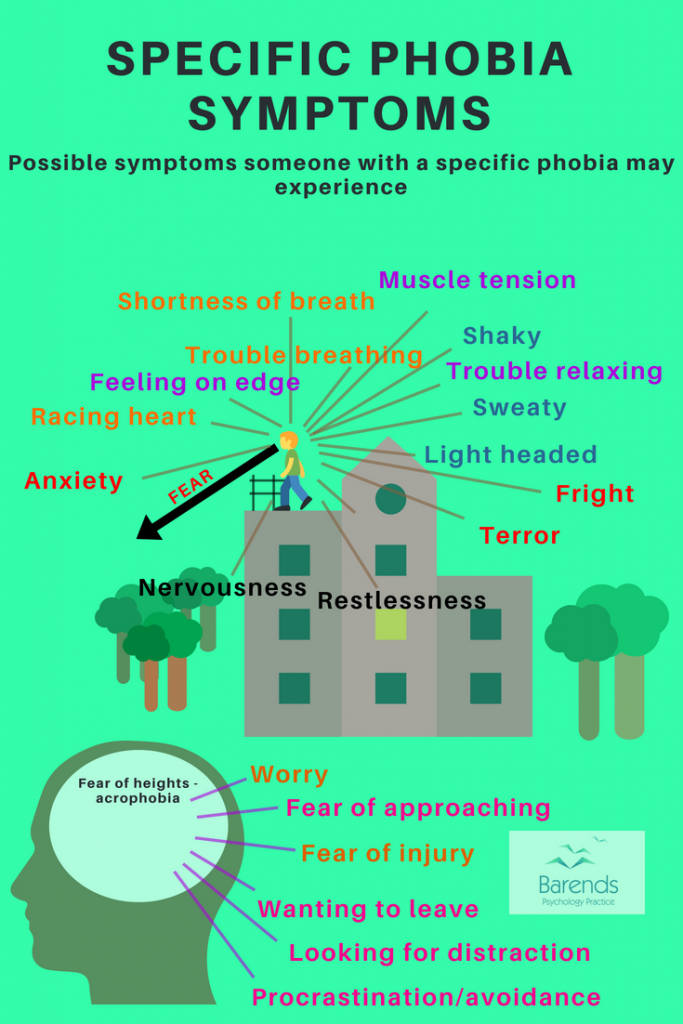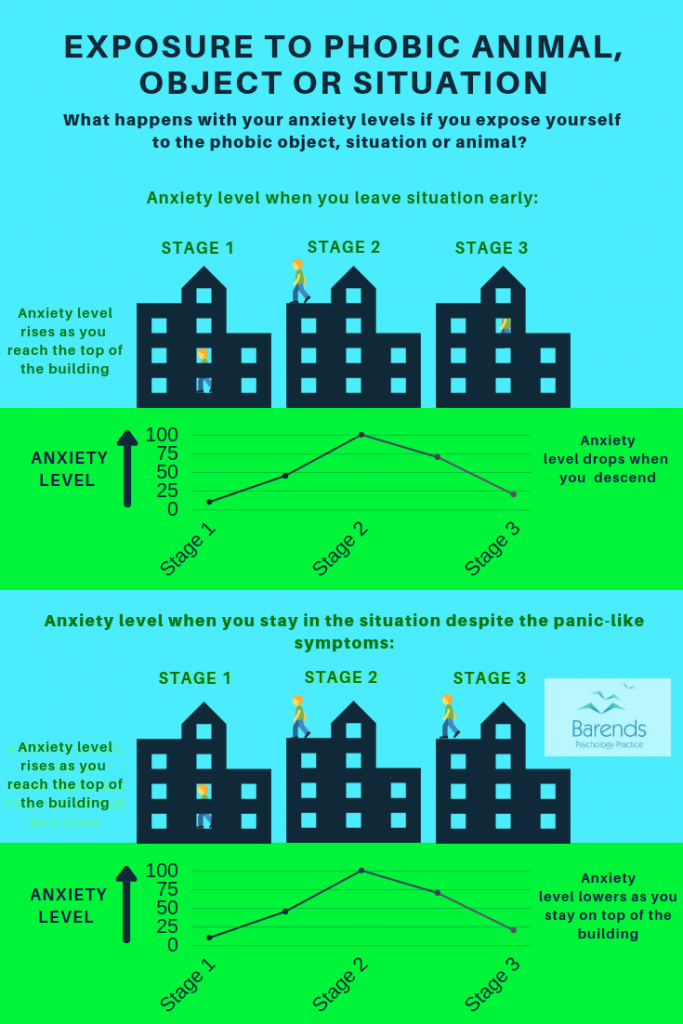What are specific phobias?
Before we can start coping with phobias, it is important to understand what a specific phobia is. A specific phobia is characterized by an excessive and disproportionate fear of an object, situation or animal. This excessive and disproportionate fear causes phobic people to experience a lot of panic-like feelings, such as breathing problems, racing heart, sweating, and strong feelings to leave the situation as soon as possible. Common specific phobias are fear of spiders (Arachnophobia), fear of dogs (Cynophobia), and fear of heights (Acrophobia). Coping with phobias usually is very difficult for phobic people, because they do not dare to come near the phobic object/situation/animal, which makes it difficult for them to understand that their fear and anxiety is irrational. On top of that, most friends and relatives respond with laughter when someone expresses their phobic fear towards something.This response makes it difficult for someone with a specific phobia to talk about their fear and do reduce the impact their symptoms have.
Fortunately, coping with phobias is easier than one may think, and with the help of this self-help guide, you will make a lot of progress in a short time. First, common triggers and anxiety provoking situations are being discussed, followed by some exercises (psycho-education) including a gradual exposure exercise, and information for the partner of someone with a specific phobia.
Please NOTE: we recommend you to contact a therapist to discuss treatment options and/or to guide you through the process discussed on this page. Coping with phobias on your own can be counter-effective if the exercises are practiced in a wrong way. For instance, using the Brazilian Wandering Spider to get over your Arachnophobia can be fatal. In case you are doing this with someone else, please make sure you trust that person completely. Their response is crucial to reduce the phobia symptoms or to help you with these exercises.
This self-help page is only meant for those who have mild to moderate specific phobia. Click here, to take the online and anonymous specific phobias test to see how severe your specific phobia is.
Go to:
At Barends Psychology Practice, we offer (online) counseling for specific phobias. Contact us to schedule a first, free of charge, online session. (Depending on your health insurance, treatment may be reimbursed).
Coping with phobias – Explaining triggers
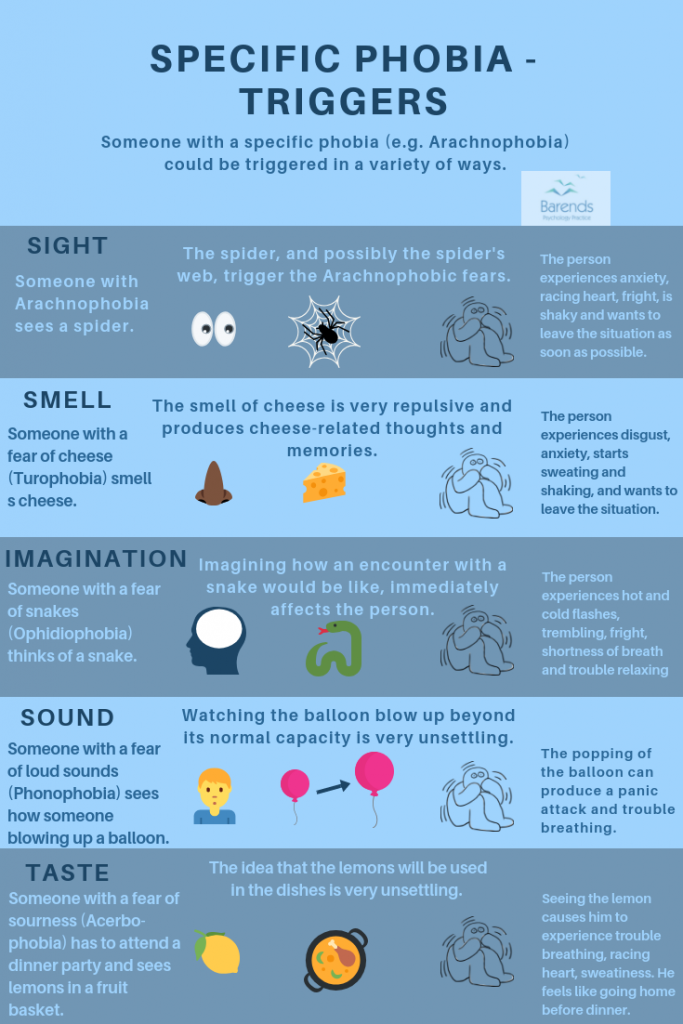
There is always a reason why someone experiences one or more of the specific phobia symptoms (e.g. trouble breathing, anxiety, fright, racing heart). For someone with a specific phobia, this reason is somehow related to the phobic situation, animal or object. Someone with Arachnophobia (fear of spiders) may experience these specific phobia symptoms when seeing a spider in real, on television or in a magazine. In some cases, it is even possible that there is no trace of a spider (or its web), but that the person suffering from Arachnophobia still experiences these typical specific phobia symptoms. A possible explanation could be that someone experiences a traumatic experience with a spider in that room or situation.
As can be seen in the image above or on the right side, these triggers cause symptoms typical for specific phobia. The avoidance symptoms are the ones that prevent someone from testing their irrational fear, because (1) the avoidance symptoms prevent an encounter with the phobic animal/situation/object or (2) the focus during the encounter with the phobic animal/situation/object is on the anxiety and panic they feel, and on leaving the place. In the latter situation, two things will be remembered: (1) encountering a phobic object/animal/situation produces panic-like symptoms, and (2) leaving the place makes these symptoms disappear, and not being able to leave the place early increases the panic. It is common for partners of phobic people to defend the person with the phobia by taking out the spider or snake, for instance. This is another type of avoidance, of course. Coping with phobias is, therefore, extremely difficult.
Fortunately, by testing the right hypothesis, we can reduce the severity of the specific phobia symptoms. Continue reading to learn how to do this.
Coping with phobias – Reducing anxiety
Despite the fact that treatment for specific phobias is very effective, it is not always possible to finish treatment before having a (planned) encounter with the phobic object/animal/situation. For instance, when someone with Aviophobia (fear of flying) needs to fly from one city to another for work. For this person, coping with phobias is very important; it helps the person stay calm right before and during the flight. There are a couple of things you can do:
Educate yourself
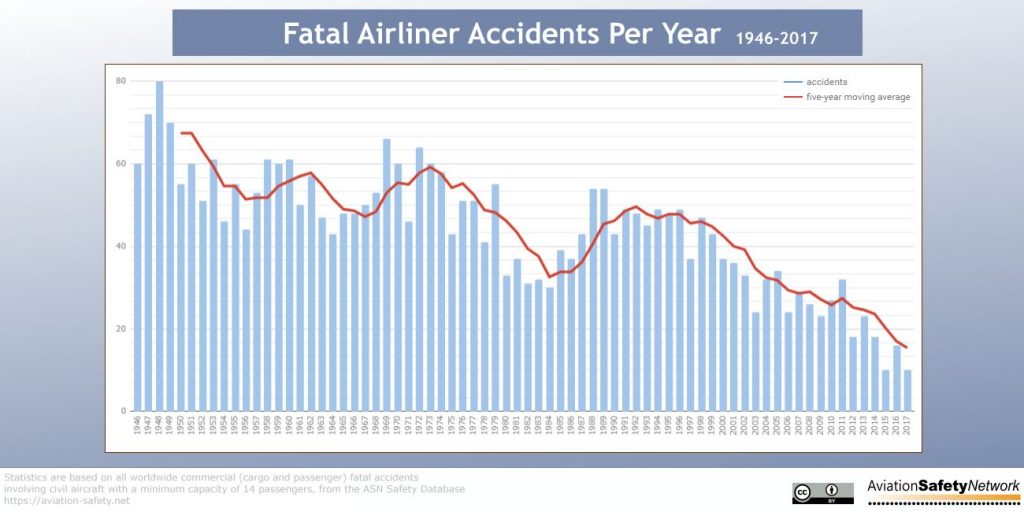
This is probably the easiest: educate yourself. Browse the internet, visit a library or call an organisation specialized in the object/situation/animal you fear so much. Try to avoid reading up on case studies. A case study is a study about 1 event during a specific time and place. For instance, reading up on that one time that EL AL Flight 1862 crashed into Groeneveen and Klein-Kruitberg in 1992 will most likely increase the fear of flying significantly, and doesn’t say anything about your upcoming flight(s).
Instead of focusing on one single flight, it is better to take a look at all the flights worldwide and count the amount of aviation accidents. In the graph above/to the right you can see the amount of fatal accidents per year from 1946 – 2017. When you compare the amount of fatal accidents with the annual amount of flights per year: +30.000.000 (more than 30 million flights per year), it is clear that flying is extremely safe [1].
Next to focusing on aviation accidents, it may also be very helpful to look into the long and intensive training pilots have to complete before they are allowed to fly passengers. The Royal Dutch Airlines KLM, for instance, has a very strict and long screening procedure involving several tests and psychological assessment before someone is even allowed to start the training program. On top of that, they have annual check-ups to test their knowledge. And before every flight, pilots and/or flight engineers check the airplane thoroughly for damage and malfunction.
Exercises
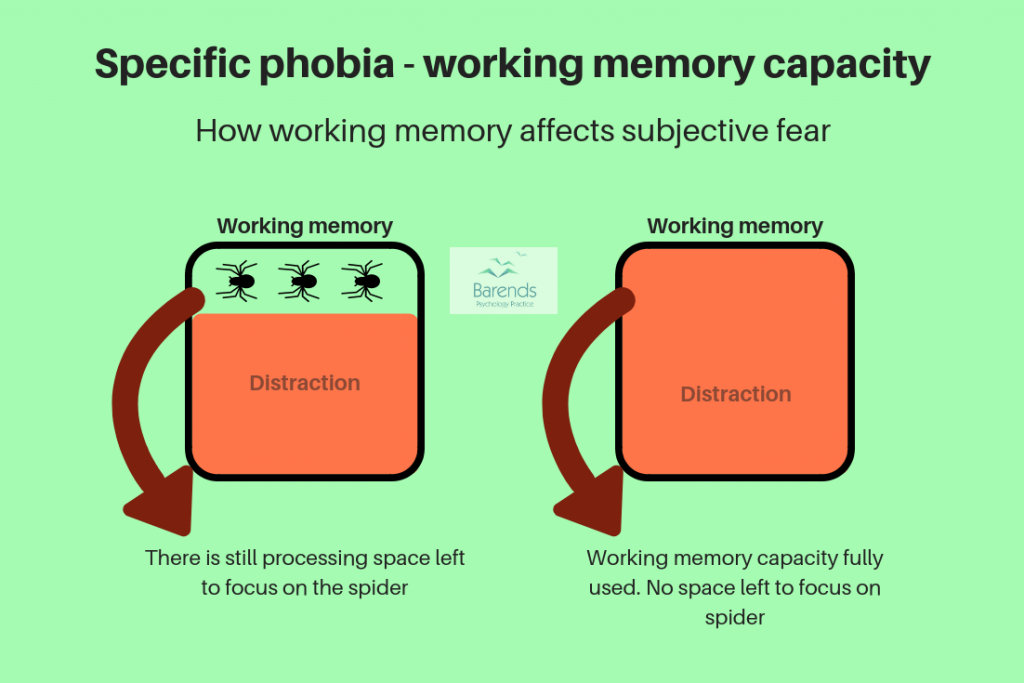
Although coping with phobias is not the same as a phobia treatment, it is very effective, especially when it comes to staying calm or calming down. Some exercises require some practicing or take some preparation time, so plan these exercises well ahead. There are a few exercises you can do to calm down:
Breathing exercise:
Breathing exercises: breathing exercises reduce the effects of stress and strain on the body and improve the physical and mental health [2],[3],[4],[5]. By practicing the below mentioned breathing exercise two times per day for the first two weeks, it is easier to apply when you face the phobic animal, object, or situation. An example:
- (A) Close one nostril with the thumb and slowly inhale through the other nostril for 6 seconds.
- (B) Hold breath for 6 seconds and then exhale for 6 seconds through the other nostril.
- (C) Close one nostril with the thumb and slowly inhale through the other. Hold your breath for 6 seconds while keeping both nostrils closed, after which you can exhale through the other nostril.
- (D) Repeat these three steps for about 30 minutes.
This breathing exercise will help you to calm down, and slows down the blood flow through your heart, which in turn slows down your heartbeat.
Distraction:
Distracted exposure (distracting yourself while being exposed to a phobic situation/animal/object) reduces the subjective fear significantly compared to no distraction at all [6],[7]. External distractors work better than internal distractors to reduce fear levels [7]. Be sure to find distractions that require some active thinking/working memory, because passive distractors (such as listening to music) is not an effective distractor. Passive distractors allow the person to keep thinking of the phobic stimulus [8]. In case you are afraid of car rides, it may be an idea to make sentences with letters on license plates. For those who are afraid of spiders, focusing on your phone or others around you may be very helpful. Your partner can play an important role, because they can serve as a safety signal/sign and as a great distraction. Talking to someone, especially someone you trust, helps people to focus on the story or on that person. Be sure to avoid talking about the phobic animal/object/situation, and instead, talk about things that are interesting and require some active thinking. While talking to your partner you may notice that your anxiety levels drop, your heart beat slows down a little bit, and that the situation is manageable.
Muscle relaxation:
Progressive muscle relaxation helps you to relax your muscles when you are anxious and stressed, and when your muscles are tensed. Muscle relaxation also improves sleep, and reduces physical problems, such as headaches and stomachaches [10]. You need approximately 20 to 10 minutes for this exercise (depending on how much practice you’ve had) and we recommend you to practice this twice a day for the first two weeks. WARNING: do not try this exercise if you have an injury. Progressive muscle relaxation involves tensing and relaxing nine muscle groups [11]: (a) hands and forearms; (b) upper arms; (c) forehead; (d) eyes, nose, and cheeks; (e) jaw, chin, front of neck; (f) back of neck; (g) upper body; (h) legs up with toes pointed down; and (i) legs up with toes pointed up. This is how to do it:
- Step 1: Find a warm and comfortable place to sit and make sure you are relaxed/calm before starting this exercise. Wear comfortable clothing.
- Step 2: Take 5 slow, deep breaths and select one of the above mentioned muscle groups to start with.
- Step 3: Take a deep breath (again) and apply tension on the muscle group for approximately 15 seconds. It is important to feel the tension in the muscles, which may cause a bit of shaking or discomfort.
People easily also apply tension to the surrounding muscles. The exercise becomes easier when you only focus on one muscle group. - Step 4: Exhale and release the tensed muscles quickly. Notice how your muscles become weak and limp for about 30 seconds. Be sure to feel the difference between tensed and relaxed muscles; this is the most important part of the exercise.
- Step 5: Move on to the next muscle group and repeat steps 1-5.
When facing the phobic animal, object or situation, it is helpful to know how to relax your muscles when they are tense. This will help you to calm down quicker. By focusing on a tensed muscle group you can release the tension and move on to the next muscle group.
Meditation:
Clinically Standardized Meditation (CSM), which is similar to mantra meditation (without phonetic restrictions), reduces somatic, cognitive, and general state anxiety [10]. In the beginning, CSM is practiced two times per day for 20 minutes. When you is familiar with the procedure, you can reduce it to once per day or a few times per week.
Picking a neutral mantra is very important for mantra meditation or CSM to be effective. A mantra is a word that needs to be repeated during meditation. Mantra’s related to negative feelings or profanity (such as hate, kill) are not recommended.
- Step 1: Make sure you sit in a comfortable position with your eyes open, and focus on a pleasant object.
- Step 2: Repeat the mantra aloud, slowly, and rhythmically. Slowly decrease the volume until you whisper the word, and eventually it is only a thought. Close your eyes while repeating the mantra.
You can also repeat the mantra mentally (without making sounds) from the beginning.
It is important to notice that you stick to your own rhythm and speed. - Step 3: Breath passively and independently of the repetition of the mantra.
- Step 4: If you notice that your mind wanders to other thoughts, please kindly bring it back to focus on the mantra.
This exercise will reduce the general state anxiety and can also be applied when facing the phobic animal, object, or situation. By repeating the mantra mentally, you will calm down quickly, which makes coping with phobias a lot easier.
Nutritional and herbal supplements
Nutritional and herbal supplements are effective in the treatment of phobias, and make coping with phobias easier, without the risk of serious side effects [12]. The best herbal supplements contain extracts of passionflower or kava, and combinations of L-lysine and L-arginine. Lysine and Arginine are an amino-acids needed to build proteins and supports your immune system. They can be found in:
- Chickpeas and humus,
- Avocados,
- Kidney beans, black beans, and navy beans,
- Dried apricots and mangoes,
- Leeks,
- Tempeh,
- Tomatoes,
- Tofu,
- Pears,
- Soybeans and soymilk,
- Green and red peppers,
- Potatoes,
- Lentils,
- Edamame,
- Buckwheat,
- Cashews, pistachios, and macadamia nuts,
- Pumpkin seeds, and
- Quinoa.
St. John’s wort is not effective in the treatment of phobias, and it does not help coping with phobias.
Medication
Anxiety reducing medications (Beta-blockers) reduce your blood pressure by blocking the effects of the hormone epinephrine (also known as adrenaline). Beta-blockers slow down your heartbeat, open up your blood vessels which increases the blood flow. This helps people to stay calm when they are facing a phobic animal/situation/object [9]. Beta-blockers can be taken 30 minutes in advance and work really good during public performances and exams.
Realistic thinking
Anxious thoughts related to the phobic animal, situation, or object are often unrealistic, or very unlikely. When you are in a calm state, you can see clearly that these thoughts are unrealistic and irrational, but when you are very anxious, it is very difficult to recognize this. An example to illustrate this: someone who once vomited after eating a whole can of hotdogs, may believe that sticking objects with a hotdog shape in their mouth will make them vomit again. The idea of sticking a hotdog or sausage in their mouth, may already make them very anxious. Coping with phobias, in this case, is often difficult because this person will avoid eating hotdogs or sausages.
Another example: someone with an escalator phobia may avoid escalators because they believe that the escalator step will fall down.
These irrational fears can be challenged by analysing the situation and fears. In the hotdog example, the person probably vomited because he had too many hotdogs at once. Sticking a hotdog in their mouth will not result in vomiting. In the escalator example, the person could call several escalator factories and ask them about the chance of this happening. They may even observe the escalators of the underground during rush hour to see how often the escalator steps actually fall down.
Preparation
A good preparation helps people to stay calm as well. Knowing what you can expect, creates peace and offers distraction: you can focus on your preparation. A good example is studying the airport plan before arrival, especially when you have to change flights. Coping with phobias is easier when you are well prepared, because it calms you down a lot.
Coping with phobias – Exposure
Theory: Emotions, feelings, and thoughts are temporary: they come and go. Fear, for instance, may come up suddenly (especially when facing a feared object or animal) and disappears after a while. Even if someone stays near the feared object or animal, the emotion fear will disappear eventually.
It’s this principle (emotions, feelings, and thoughts come and go) that we’ll use in the exposure exercise. This principle will be combined with a good hypothesis to make sure that the exercise is as effective as possible, and makes coping with phobias easier.
Before we focus on the good hypothesis, we need to know what a bad hypothesis is. A bad hypothesis is a hypothesis we cannot really work with. A bad hypothesis focuses on superficial emotions and feelings without going deeper. For instance, someone with a fear of heights may be afraid of cliffs or lighthouses. A bad hypothesis would be: Whenever I climb a lighthouse, I panic. <– this hypothesis is probably always true and only tests fear on a superficial level. The fear will return each time. It does not tackle the real fear: jumping or falling down. Only by tackling the real fear, we’ll see a reduction in anxiety levels.
A good hypothesis can only be formed once we know what your biggest fear is regarding the specific phobia. For instance, the biggest fear of someone with a fear of spiders may be the fear of a fatal bite from a spider. Of course, the chance that this actually happens is extremely small. Therefore, it is safe to test this biggest fear. After a few times, someone will understand that a spider does not even attack a person, which in turn reduces anxiety levels. This is a success experience and will be registered in your brains.
It is important to understand that someone will experience panic-like symptoms when facing a spider. This is not something to worry about. Now that we understand some of the theory behind the exercises, we can get started with effectively coping with phobias.
Exercise:
-
- Create a hierarchical list of the things you fear the most. For instance, 2 floors, 3 floors, 4 floors, 6 floors, top of a lighthouse, close to a cliff, and on top of the Burj Khalifa, UAE, in case you are afraid of heights. For people with Arachnophobia: being in the same room with a caged spider, sitting on a chair in a room with a caged spider, sitting close to the caged spider, being in the room with a spider, standing near a spider, approaching a spider, touching a spider. A benefit of a hierarchical list, compared to no list, is that it is easier to get started with exposure.
- Determine what your biggest fear is in regards to your specific phobia. Ask yourself the following question over and over: What do I fear most when I encounter the animal/object I fear the most?…. and if this happens, what is the worst thing that can happen?… and if this happens, what is the worst thing that can happen? and so on. A tip: your biggest fear often has something to do with death, severe injuries or loss.
- Create a good hypothesis and make sure that there is at least 80% chance of a success experience when you expose yourself to the phobic object, animal or situation. Discuss this hypothesis with someone you trust. An good hypothesis could be: I will not faint/die/get fatally injured when I expose myself to a spider. This step is very difficult and we strongly recommend you to contact a therapist or specialist in this field. A negative experience may result in a stronger case of phobia and may result in losing faith in therapy altogether. Worst case scenario, you may injure yourself. Coping with phobias sometimes means asking for help where needed.
- Prepare well: Practice breathing techniques as described above, and in cases of fear of objects or animals: read up on their behaviour/movements, and use a safety object or safety behaviour during the first times you expose yourself to these animals, objects or situations. Take, for instance, a friend with you when you are entering a lighthouse if you are afraid of heights. Your friend will be able to calm you down and gives you a sense of protection/safety. The friend in this example is the safety object. Make sure that you trust the friend and that he or she does not make fun of you for exposing yourself to the phobic animal, situation, or object.
- Select the phobic situations, animals or objects. You don’t want to try to get rid of your Cynophobia (fear of dogs) by exposing yourself to a vicious dog. Neither would exposure to a Banana spider (Phoneutria) be a very wise thing to do. Instead, pick a calm (old) dog, a harmless little non-jumping spider, balconies with enough protection, and so on.
- Focus on progress and not on success or failure. You cannot expect yourself to succeed each time. Every tiny bit of positive exposure to the phobic situation, object or animal is important. The end goal is to reduce the anxiety levels and to be able to deal with the phobic situation, animal or object when needed. The end goal is not to be the best dog handler or to become a skydiver.
- Calm down right before you exposure yourself to the least difficult/anxiety provoking situation on your list. Then try to exposure yourself to the feared animal, object or situation.
- During the exposure, do not leave the situation before you are fully calmed down. You’ll notice that the moment you see, feel or hear the presence of the fear object, animal or situation, that you’ll experience panic-like feelings. Remember: they are temporary and will go away. Try to stay in the situation for as long as possible and only try to leave when you are completely calm.
- Ask yourself the question if your worst fear came true?
- Repeat this exercise until you feel comfortable enough to move to the next one on your list. Don’t forget to stay in the situation until you are completely calm, and don’t forget to ask yourself if your worst fear came true.
NOTE: this exercise is only for those people who have a mild or moderate specific phobia and who are able to expose themselves in a controlled and safe way to the phobic object, situation or animal. Coping with phobias can be very tricky and challenging.
Doing the above mentioned exercise is at your own risk and responsibility.
We are more than happy to assist you along the way. Also, we offer specific phobia treatment.
Coping with phobias – Literature
- [1] Aviation safety network.
- [2] Bhargava, R., Gogate, M. G., & Mascarenhas, J. F. (1988). Autonomic responses to breath holding and its variations following pranayama. Indian J Physiol Pharmacol, 32, 257-64.
- [3] Telles, S., Nagarathna, R., & Nagendra, H. R. (1994). Breathing through a particular nostril can alter metabolism and autonomic activities. Indian Journal of Physiology and Pharmacology, 38, 133-133.
- [4] Mohan, M., Saravanane, C., Surange, S. G., Thombre, D. P., & Chakrabarty, A. S. (1986). Effect of yoga type breathing on heart rate and cardiac axis of normal subjects. Indian J Physiol Pharmacol, 30, 334-40.
- [5] Pal, G. K., & Velkumary, S. (2004). Effect of short-term practice of breathing exercises on autonomic functions in normal human volunteers. Indian Journal of Medical Research, 120, 115.
- [6] Kamphuis, J. H., & Telch, M. J. (2000). Effects of distraction and guided threat reappraisal on fear reduction during exposure-based treatments for specific fears. Behaviour research and therapy, 38, 1163-1181.
- [7] Oliver, N. S., & Page, A. C. (2008). Effects of internal and external distraction and focus during exposure to blood-injury-injection stimu.li. Journal of Anxiety Disorders, 22, 283-291.
- [8] Lahmann, C., Schoen, R., Henningsen, P., Ronel, J., Muehlbacher, M., Loew, T., … & Doering, S. (2008). Brief relaxation versus music distraction in the treatment of dental anxiety: a randomized controlled clinical trial. The Journal of the American Dental Association, 139, 317-324.
- [9] Patston, T., & Loughlan, T. (2014). Playing with performance: The use and abuse of beta-blockers in the performing arts. Victorian Journal of Music Education, 3.
- [10] Rausch, S. M., Gramling, S. E., & Auerbach, S. M. (2006). Effects of a single session of large-group meditation and progressive muscle relaxation training on stress reduction, reactivity, and recovery. International Journal of Stress Management, 13, 273.
- [11] Gramling, S. E., & Auerbach, S. E. (1998). Stress management workbook: Techniques and self-assessment procedures. Englewood Cliffs, NJ: Prentice Hall.
- [12] Lakhan, S. E., & Vieira, K. F. (2010). Nutritional and herbal supplements for anxiety and anxiety-related disorders: systematic review. Nutrition journal, 9, 42.

